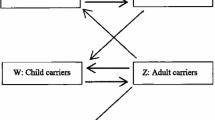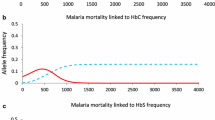Abstract
We formulate a realistic demographic model that captures the pattern of inheritance of the S gene, which is responsible for the most common genetic defect, namely, sickle-cell anaemia (SCA), using general pair formations. The model equation is implicitly solved via the Laplace transform technique, while the existence of a unique solution is proved by applying the contraction mapping principle. One of the main results is the boundedness of the solution. A fundamental reason for the persistence of SCA is probably due to the role played by the selective advantage of the abnormal S gene over the normal haemoglobin A in tropical regions, and the fact that carriers are more fertile and survive longer (a property known as hybrid vigor), because they are essentially asymptomatic. We also discuss possible public health policies.
Similar content being viewed by others
References
Aldelson, M., 1976. An Introduction to Epidemiology. Macmillan, London.
Allison, A.C., 1963. Genetical Variation in Human Populations. Pergamon, Oxford.
Bainov, D., Simeonov, P., 1992. Integral Inequalities and Applications. Kluwer Academic, Dordrecht, The Netherlands.
Barlett, M.S., 1960. Stochastic Population Models in Ecology and Epidemiology. Methuen/Wiley, New York/London.
Caswell, H., 1989. Matrix Population Models. Sinauer Associates, Sunderland, MA.
Caswell, H., 2001. Matrix Population Models, Construction, Analysis and Interpretation. Sinauer Associates, Sunderland, MA.
Castillo-Chavez, C., 1990. Towards a unified theory of pair formation. In: Third Autumn Course on Mathematical Ecology, SMR. pp. 478–442.
Castillo-Chavez, C., Busenberg, S., 1991a. Pair formation in structured populations. In: Goldstein, J.A., Kappel, F., Schappacher, W. (Eds.), Differential Equations with Applications in Biology, Physics and Engineering. Lecture Notes in Pure and Applied Mathematics, vol. 133, pp. 47–65.
Castillo-Chavez, C., Busenberg, S., 1991b. On the solution of the two-sex problem. In: Busenberg, S., Martelli, M. (Eds.), Proceedings of the International Conference on Diff. Eqns. Appl. Biol. and Pop. Dynam. Lecture Notes in Biomathematics 92, 80–98, Springer-Verlag, Berlin-Heidelberg-New York.
Castillo-Chavez, C., Huang, W., 1995. The logistic equation revisited: The two-sex case Math. Biosci. 128, 299–316.
Castillo-Chavez, C., Huang, W., Li, J., 1996. On the existence of stable pair distributions. J. Math. Biol. 34, 413–441.
Castillo-Chavez, C., Velasco-Hernandez, J.X., Fridman, S., 1994. Modeling contact structures in bioogy. In: Levin, S.A. (Ed.), Frontiers of Theoretical Biology. Lecture Notes in Biomathematics, vol. 100. Springer, Berlin.
Castillo-Chavez, C., Yakubu, A.-A., Thieme, H., Martcheva, M., 2002. Non-linear mating models for population with discrete generations. In: Castillo-Chavez, C., van den Driessche, P., Kirscher, D., Yakubu, A.-A. (Eds.), Mathematical Approaches for Emerging and Re-Emerging Infectious Diseases: An Introduction, IMA, vol. 125. Springer, Berlin, pp. 251–268.
Cavalli-Sforza, L.L., Bodner, W.F., 1971. The Genetics of Human Populations. Freeman, San Francisco.
Charlesworth, B., 1980. Evolution in Age Structured Populations. Cambridge University Press, Cambridge, MA.
Chukwu, A.A., Tchuenche, J.M., 2005. Solution of a simple advection diffusion population model. Int. J. Ecol. Econ. Stat. 3(S05), 72–78.
Cushing, J.M., 1988. An Introduction to Structured Population Dynamics, CBMS-NSF Regional Conference Series in Applied Mathematics. SIAM, Philadelphia, PA.
Dean, J., Schechter, A.N., 1978. Molecular and cellular base of therapeutic approaches. New Engl. J. Med 299(14), 752–762.
Diggs, L.W., 1980. Sickle cell centers of tomorrow. Part I: Regional information centers. South. Med. J. 73(2), 188–194.
Edwards, R., Telfair, J., Cecil, H., Lenoci, J., 2004. Self- efficacy as a predictor of adult adjustment to sickle cell diseae: One-year outcomes. Retrieved September 4, 2005, from http://www.psychosomaticmedicine.org/cgi/content/full/63/5/850
Eldestein, S.T., 1986. The Sickle Cell: From Myths to Molecules. Howard University Press, Cambridge, MA.
Ewens, W.J., 2004. Mathematical Population Genetics. I. Theoretical Introduction, 2nd ed. Springer, New York.
Felsenstein, J, 2003. Theoretical Evolutionary Genetics. Available at http://evolution.gs.washington.edu/pgbook/pgbook/html
Fredrickson, A.G., 1971. A mathematical theory of age structure in sexual populations: Random mating and monogamous marriage models. Math. Biosci. 20, 117–120.
Gale, J.S., 1980. Population Genetics. Blackie and Sons, Glasgow.
Gary, L.E., 1977. In: Baer, A.S. (Ed.), The Sickle-Cell Controversy in Heredity and Society. Macmillan, London.
Goodman, L.A., 1953. Population growth of the sexes. Biometrics 9, 213–225.
Hadeler, K.P., 1989. Pair formation in age-structured populations. Acta Appl. Math. 14, 91–102.
Hadeler, K.P., 1993. Pair formation with maturation period. J. Math. Biol. 32, 1–15.
Hadeler, K.P., Waldstatter, R., Wörz-Busekros, A., 1988. Models for pair formation in bisexual populations. J. Math. Biol. 26(6), 635–649.
Hartl, D.H., Clark, A.J., 1997. Principles of Population Genetics, 3rd ed. Sinauer Associates, Sunderland, MA.
Hille, E., Phillips, R.S., 1957. Functional analysis and semigroups. Am. Math. Soc. Coll. Publ. 31, American Mathematical Society, Providence, Rhode Island, pp. 256–271.
Hoppensteadt, F.C., Peskin, C.S., 1992. Mathematics in Medicine and the Life Sciences, Texts in Applied Mathematics, vol. 10. Springer, Berlin.
Hoskins, R.F., 1999. Delta Functions: Introduction to Generalized Functions. Horwood Series in Mathematics and Applications, Horwood, Chichester, UK.
Hsia, D.Y., 1969. The detection of heterozygous carriers. Med. Clin. North Am. 53, 857–874.
Kecton, W.T., 1972. Biological Science, 2nd ed. W.W. Norton, New York, pp. 229–235.
Kimbir, A.R., 1995. A Mathematical Model of the Transmission Dynamics of Human Schistosomiasis. Ph.D. Thesis, Faculty of Science, University of Ibadan, Nigeria.
Kimura, M., Ohta, T., 1974. Probability of gene fixation in an expanding finite population. Proc. Natl. Acad. Sci. U.S.A. 71(9), 3377–3379.
King, R.C., 1965. Genetics. Oxford University Press, New York, pp. 237–240.
Konotey-Ahulu, F.I.D., 1974. The sickle-cell disease: Clinical manifestations including the “sickle crisis”. Arch. Int. Med. 133, 611–619.
Kooi, B.W., Kelpin, F.D.L., 2003. Physiologically structured population dynamics, a modelling perspective. Comments Theor. Biol. 8(2/3), 125–168.
Kotila, T.R., Adeyemo, A.A., Abbiyesuku, F.M., Shokunbi, W.A., 2000. Betke's and elution methods in estimation of haemoglobin F in sickle-cell anaemia. East Afr. J. 77(3), 40–43.
Kotila, T.R., Shokunbi, W.A., 2003. Haemoglobin F in healthy Nigerian adults. West Afr. J. Med. 22(2), 143–145.
Light, W.A., 1990. An Introduction to Abstract Analysis. Chapman and Hall, London.
Lorey, F.W., Arnopp, J., Cunningham, G.C., 1996. Distribution of hemoglobinopathy variants by ethnicity in a multi-ethnic state. Gen. Epidemiol. 13(5), 501–512.
Lubkin, S., Hsu Schmitz, S.-F., Castillo-Chavez, C., 1995. A framework for modelling inheritance of social traits. In: Arino, O., Axelrod, D.E., Kimmel, M. (Eds.), Mathematical Population Dynamics: Analysis of Heterogeneity, Vol. 1, Theory of Epidemics, Wuerz Publishing Ltd., Canada. pp. 131–146.
Lutz, F., 2003. Lecture Notes. Retrieved August 31, 2005, from http://homepages.strath.ac.uk/dfs99109/BB211/HeteroAdvLect.html
MacDonald, A.S., 1999. Modelling the impact of genetics on insurance. North Am. Actuarial J. 3(1), 83–101.
MacDonald, A.S., Pitchard, D., 2000. A mathematical model of Alzheimer's disease and the APOE gene. ASTIN Bull. 30(1), 69–110.
Malecot, G., 1969. The Mathematics of Heredity (Revised, edited and translated by Yermanos, D.M.). Freeman, San Francisco.
Martcheva, M., Milner, F.A., 2001. The mathematics of sex and marriage, revisited. Math. Pop. Stud. 9(2), 123–141.
Mather, K., 1973. Genetical Structure of Populations. Chapman and Hall, London.
McFarland, D.D., 1972. Comparison of alternative marriage models. In: Greville, T.N.E. (Ed.), Population Dynamics. Academic Press, New York, pp. 89–106.
Metz, J.A.J., Diekmann, O., 1986. The Dynamics of Physiologically Structured Populations, Lecture Notes in Biomathematics, vol. 68. Springer, Berlin.
Mewoli, B., 1978. Dynamique de la population. In: Mewoli, B. (Ed.), Mathematical Modelling and Applications. Part 1: African Research Notes in Mathematical Sciences, pp. 20–27.
Milner, F.A., Babbiolo, G., 1992. Rapidly converging numerical algorithms for models of population dynamics. J. Math. Biol. 30, 733–753.
Neel, J.V., 1949. The sickle-cell anaemia. Science 110, 65–66.
Nisbet, R.M., Gurney, W.S.C., 1986. The formulation of age-structure models. In: Hallam, T.G., Levin, S.A. (Eds.), Mathematical Ecology, An Introduction, Springer-Verlag, W. Germany, pp. 95–115.
Ohaeri, J.V., Shokunbi, W.A., Akinlade, K.S., Dare, L.O., 1995. The psychosocial problems of sickle-cell disease sufferers and their methods of coping. Soc. Sci. Med. 40(7), 955–960.
Pauling, L., Itano, H.A., Singer, S.J., Wells, I.C., 1949. Sickle-cell anaemia, a molecular disease. Science 110, 441–450.
Pitt, H.R., 1963. Integration Measure and Probability, University Monographs. Oliver and Boyd, London, UK.
Platt, O.S., Brambilla, D.J., Rosse, W.F., Milner, P.F., Castro, O., Steinberg, M.H., Klug, P.P., 1994. Mortality in sickle-cell disease: Life expectancy and risk factors for early death. New Engl. J. Med. 330(23), 1939–1644.
Powars, D., Chan, L.S., Schroeder, W.A., 1990. The variable expression of sickle cell disease is genetically determined. Semin. Hematol. 27, 360–376.
Pruss, J., Shappacher, W., 1994. Persistent age-distributions for pair-formation model. J. Math. Biol. 33, 17–33.
Reed, W., Vichinsky, E.P., 1998. New considerations in the treatment of sickle-cell disease. Ann. Rev. Med 49, 461–474.
Rice, S.H., 2004. Evolutionary Theory: Mathematical and Conceptual Foundations. Sinauer Associates, Sunderland, MA.
Rosen, K.H., 1983. Mathematical models for polygamous mating systems. Math. Model. 4(1), 27–40.
Rosen, R., 1993. On models and modeling. Appl. Math. Comput. 56, 359–372.
Rubinov, S.I., 1972. Mathematical problems in the biological sciences. CBMS-NSF Regional Conference in Applied Mathematics 10, pp. 9–30.
Serjeant, G.R., 1994. The geography of sickle cell disease: Opportunities for understanding its diversity. Ann. Saudi Med. 14(3), 237–246.
Serjeant, G.R., Serjeant, B.E., 2001. Sickle Cell Disease. Oxford University Press, Oxford.
Sharpe, F.R., Lotka, A.J., 1911. Numerical bifurcation analysis of a tri-trophic food web with omnivory. Phil. Mag. 21, 435–438.
Singer, K., Chenoff, A.I., Singer, L., 1951. Studies on abnormal haemoglobins. 1: Their demonstration in sickle-cell anaemia and other haematologic disorders by means of alkali denaturation. Blood 6, 413.
Sinko, J.W., 1969. A new mathematical model for describing the age–size structure of a population of simple animals. Ph.D. Thesis, Department of Electrical Engineering, University of Rochester, New York.
Slobodkin, L.B., 1953. An algebra of population growth. Ecology 34(3), 513–519.
Smart, D.R., 1974. Fixed Point Theorems. Cambridge University Press, Cambridge, MA.
Sneddon, I.N., 1972. The Use of Integral Transforms. McGraw-Hill, New York.
Sowunmi, C.O.A., 1976. Female dominant age-dependent deterministic population dynamics. J. Math. Biol. 3(2), 9–17.
Sowunmi, C.O.A., 1988. Saturation processes. Maht. Comput. Model. 11, 250–252.
Sowunmi, C.O.A., 1993. A model of heterosexual population dynamics with age structure and gestation period. J. Math. Anal. Appl. 172(2), 390–411.
Sowunmi, C.O.A., 2000. Stability of steady state and boundedness of a 2-sex population model. Nonlinear Anal. 39, 693–709.
Sowunmi, C.O.A., 2004. Time discrete 2-sex population model with gestation period. In: Mathematical Modelling of Population Dynamics. Banach Center Publications 63, 259–266.
Streifer, W., 1974. Realistic models in population ecology. In: MacFadyen, A. (Ed.), Advances in Ecological Research, vol. 8. Academic Press, London.
Tchuenche, J.M., 2005e. Evolution Equation in a Population with an Additional Structure: A Simple Derivation, West Afr. J. Bioph. Biomath. 2, 1–7.
Tchuenche, J.M., 2002. Mathematical population dynamics of a sickle-cell anaemia, a genetically transmitted disease. Ph.D. Thesis, Faculty of Sciences, University of Ibadan, Nigeria.
Tchuenche, J.M., 2005a. Realistic patterns of inheritance o sickle-cell anaemia gene. J. Biol. Syst. 13(1), 13–22.
Tchuenche, J.M., 2005b. Effects of the selective advantage of HbS over HbA in the transmission dynamics of sickle-cell anaemia. Adv. Complex Syst. 8(1), 1–5.
Tchuenche, J.M., 2005c. The effects of migration on the transmission dynamics of sickle cell anaemia. Mediterr. J. Math. 2(3), 357–365.
Tchuenche, J.M., 2005d. An age-physiology dependent population dynamics model with polygamy. Folia Math. 12(2), (in press)
Tribe, M.A., Tallam, I., Eraut, M.R., 1978. Basic Biology Course. Unit 5: Aspect of Heredity, Book 12, Case Studies in Genetics. New York: Cambridge University Press, MA.
Tucker, S.L., Zimmerman, S.O., 1988. A nonlinear model of population dynamics containing an arbitrary number of continuous structure variables. SIAM J. Appl. Math. 48(3), 549–591.
Wallace, R.A., King, J.L., Saunders, G.P., 1986. Biology: The Science of Life. Scott, Foresman, Glenview, IL, pp. 772–778.
Watson, E.J., 1981. Laplace Transforms and Applications. Von Nostrand Reinhold, New York.
White, J.M., Lewis, S.M., 1973. Report on the interdisciplinary quantitation of haemoglobin A2 and F. J. Clin. Pathol. 26, 864–867.
Yu, M.S., Passekov, V.P., 1990. Fundamentals of evolutionary genetics. In: Mathematics and its Applications. Kluwer Academic, Dordrecht, The Netherlands.
Author information
Authors and Affiliations
Corresponding author
Additional information
2000 MS Classification: 92D25 · 92D40 · 34C60 · 35F10
Rights and permissions
About this article
Cite this article
Tchuenche, J.M. Theoretical Population Dynamics Model of a Genetically Transmitted Disease: Sickle-Cell Anaemia. Bull. Math. Biol. 69, 699–730 (2007). https://doi.org/10.1007/s11538-006-9148-y
Received:
Accepted:
Published:
Issue Date:
DOI: https://doi.org/10.1007/s11538-006-9148-y




